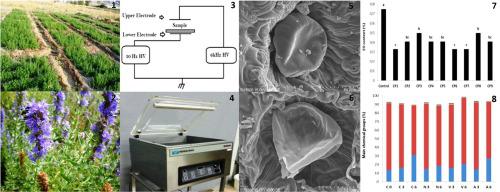Journal of Applied Research on Medicinal and Aromatic Plants ( IF 3.8 ) Pub Date : 2020-12-02 , DOI: 10.1016/j.jarmap.2020.100289 Farzaneh Jangi , Mohammad-Taghi Ebadi , Mahdi Ayyari

|
Certain post-harvest processes of medicinal and aromatic crops (MACs) such as washing, drying, cutting and milling, decontamination, packaging, and warehousing are widely applied in the industry. However, the effects of some of them on the active ingredients have been less thoroughly studied. Changes in the essential oil (EO) content and composition of hyssop leaves were studied under cold plasma treatments (voltage values of 17, 20 and 23 kV for 1, 5 and 10 min), using different packaging methods (packaged with air, nitrogen, and under vacuum) and storage duration (0, 3 and 6 months). All samples were hydro-distilled for EO content evaluation and EO composition was determined by gas chromatography and gas chromatography–mass spectrometry. In addition, color properties and structure of the glandular trichomes were studied. The results showed that cold plasma treatment significantly reduced EO content in comparison to the control, while higher intensities resulted in a greater reduction of EO. There were slight variations of a browning index between cold plasma treated samples, although no specific trend was observed. The trichomes were vulnerable to cold plasma intensity and prolongation. With increasing treatment duration at all intensities of cold plasma, important compounds such as cis-pinocamphone, trans-pinocamphone and β-pinene were reduced. The EO content was decreased with increasing storage time in all packaging methods, which was not significant in the samples packed with nitrogen gas. During the storage period, the amounts of cis and trans-pinocamphone were reduced, but β-pinene content increased. Overall, this study showed that the use of cold plasma as a new disinfection technique can cause changes in hyssop EO, while nitrogen packaging, compared to other methods, was able to preserve both EO content and components during storage.
中文翻译:

受冷血浆,包装方法和贮藏时间影响的牛膝草的质变
某些药用和芳香类作物的收获后过程,例如洗涤,干燥,切割和碾磨,去污,包装和仓储,在工业中得到了广泛应用。但是,其中一些对活性成分的作用尚未得到充分研究。使用不同的包装方法(用空气,氮气,并在真空下)和储存时间(0、3和6个月)。将所有样品进行水蒸馏以评估EO含量,并通过气相色谱和气相色谱-质谱法测定EO的组成。此外,研究了腺毛的颜色特性和结构。结果表明,与对照相比,冷等离子体处理显着降低了EO含量,而更高的强度导致EO的降低更大。尽管未观察到特定趋势,但冷血浆处理样品之间的褐变指数略有变化。毛状体很容易受到冷血浆强度和时间的延长。随着在各种冷血浆强度下治疗时间的延长,重要的化合物如减少了顺式pinocamphone,反式pinocamphone和β-pine烯。在所有包装方法中,EO含量均随着储存时间的增加而降低,这在用氮气填充的样品中并不显着。在贮藏期间,顺式和反式吡咯烷酮电话的数量减少,但β-pine烯的含量增加。总体而言,这项研究表明,使用冷等离子体作为一种新的消毒技术会导致牛膝草EO的变化,而与其他方法相比,氮气包装能够在储存过程中同时保留EO含量和成分。











































 京公网安备 11010802027423号
京公网安备 11010802027423号